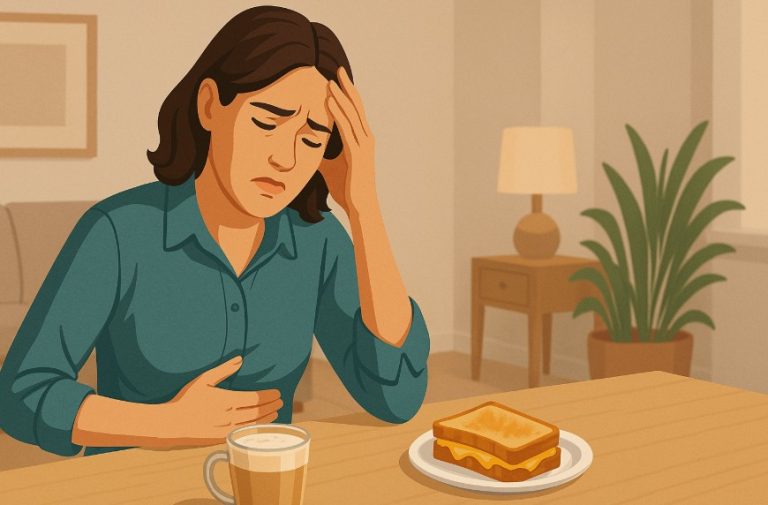Have you walked into your kitchen and discovered water pooling around the fridge? Or perhaps you have noticed small puddles forming inside the drawers and wondered what could be causing it? These situations raise the common question: why is my fridge leaking water?
Leaks are more than just an inconvenience; they can damage flooring, ruin stored food, and signal deeper issues within the appliance.
In most cases, however, the causes are relatively simple blocked drains, faulty water filters, damaged seals, or a cracked drip pan. By understanding the potential problems and knowing how to troubleshoot, homeowners can often resolve the issue without immediately calling a technician.
What Are the Main Causes of a Leaking Fridge?
Several underlying problems can cause a fridge to leak, and each one requires a slightly different approach to repair.
Why Does a Blocked Defrost Drain Cause Leaks?
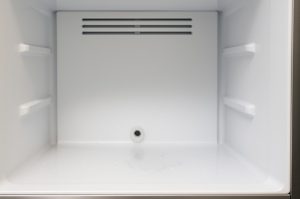
The defrost drain plays an essential role in moving water from the defrost cycle into the drip pan below the fridge. When this drain becomes clogged with crumbs, food particles, or frozen ice, water cannot pass through.
Instead, it begins to collect inside the fridge, often beneath the vegetable drawers or on the lower shelves.
How to fix a blocked defrost drain?
To clear the blockage, the fridge should be unplugged for safety. Remove any drawers covering the drain hole at the back of the freezer and gently pour warm water into the opening.
This helps melt any trapped ice. If food debris is the problem, using a pipe cleaner or thin wire can clear the obstruction. Once water flows freely into the drip pan, the leak should stop.
Could the Water Filter or Supply Line Be Causing the Leak?
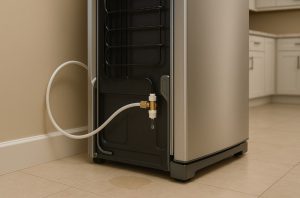
Fridges equipped with water dispensers or ice makers often rely on a supply line connected to the mains. If this line is cracked or loose, it can cause water to drip at the back or underneath the appliance.
Similarly, if the water filter is not properly installed, damaged, or overdue for replacement, it may leak inside the compartment.
How to fix water filter or supply line issues?
Start by moving the fridge slightly away from the wall to check the supply line. Inspect the tubing for splits, kinks, or damp spots. Tightening connections may solve the problem, but if the tube is cracked, it should be replaced.
Water filters should also be checked to ensure they are correctly seated. Most manufacturers recommend replacing them every six months, so a faulty filter can often be fixed with a simple replacement.
How Do Damaged Door Seals Lead to Leaks?
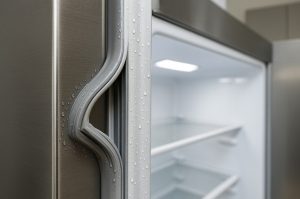
The door seals, or gaskets, keep cold air inside the fridge while blocking warm air from entering.
If the seal is cracked, torn, or no longer fits snugly, humid air seeps inside, condenses on cold surfaces, and forms droplets of water. Over time, this condensation can collect at the bottom of the fridge and appear as a leak.
How to fix damaged door seals?
Inspect the seal carefully by running your hand along its edges. If you feel cold air escaping or notice visible cracks, the gasket is no longer functioning properly.
Cleaning the seal with warm soapy water can sometimes restore flexibility if dirt or food particles are preventing a tight closure.
However, in cases of visible wear or breakage, replacing the seal with a manufacturer-approved gasket is the only lasting solution.
Can a Cracked Drip Pan Be Responsible for Water on the Floor?
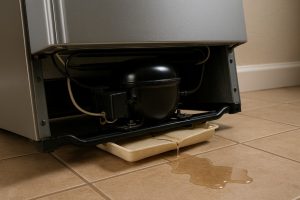
The drip pan is designed to collect condensation and water from the defrost system. Normally, the water in this pan evaporates with the heat from the compressor.
However, if the drip pan is cracked or damaged, the collected water will escape directly onto the floor, creating puddles that reappear after every cycle.
How to fix a cracked drip pan?
Unplug the fridge and locate the drip pan, which is usually positioned beneath the appliance near the compressor.
Remove it carefully and inspect for cracks or warping. If the pan is damaged, it cannot be repaired effectively and must be replaced. Replacement pans are inexpensive and widely available at hardware or appliance stores.
How Can You Identify Where the Leak Is Coming From?
Determining the exact source of a leak is essential before attempting any repair. Start by unplugging the fridge to avoid electrical hazards. Once the appliance is safe to inspect, work through the following areas:
- Drip pan: Check for cracks or overflowing water.
- Defrost drain: Inspect the freezer section for blocked drain holes.
- Door seals: Run your hand around the doors to detect escaping cold air.
- Water connections: Examine the supply line if your fridge has a dispenser or ice maker.
By systematically checking these areas, it becomes easier to narrow down whether the leak is internal, external, or connected to the freezer system.
What Should You Do If Water Is Collecting Inside the Fridge?

Finding water inside the fridge, particularly under drawers, almost always indicates a blocked drain hole. This prevents condensation and melted frost from draining properly.
How to fix internal leaks?
Remove the drawers to access the drain at the back of the compartment. Use warm water to melt any ice, followed by a thin wire or pipe cleaner to push through debris.
Once water runs into the drip tray, the problem should be resolved. To prevent future blockages, avoid placing uncovered food near the drain area and clean the hole every few months.
Why Is Water Leaking Onto the Kitchen Floor?
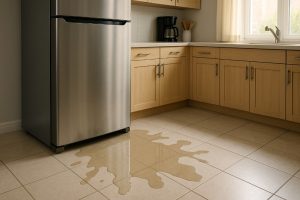
When water gathers outside the fridge, it is typically due to external components like the drip pan or the water supply line. Unlike internal leaks, these issues often cause larger puddles and can damage flooring if not addressed quickly.
How to fix external leaks?
Slide the fridge away from the wall and look underneath. If the drip pan is cracked or misaligned, replacing or reseating it will solve the issue. If the leak is traced to the water supply line, tightening the connection or replacing the tubing will be necessary.
Could Freezer Frost Build-Up Be the Cause of Leaks?
Excessive frost inside the freezer can lead to water leaking out when the ice melts. This is usually a sign that the defrost system is not working correctly or that the drain hole is frozen shut.
How to fix freezer frost leaks?
Switch off the appliance and allow the freezer to defrost naturally, placing towels around it to catch the melting water.
Once defrosted, clean and clear the drain hole. If the problem returns frequently, the defrost heater or timer may require professional servicing.
How Can You Prevent a Fridge From Leaking in the Future?
Preventive maintenance is the most effective way to avoid recurring leaks. Regular cleaning, inspections, and part replacements extend the life of the fridge and reduce the risk of water problems.
| Part of Fridge | Maintenance Frequency |
| Defrost Drain | Every 3–4 months |
| Drip Pan | Twice a year |
| Door Seals | Check quarterly |
| Water Filter | Replace every 6 months |
Simple habits like keeping food covered, avoiding overfilling shelves, and maintaining the correct temperature (between 3°C and 5°C) can also reduce condensation and strain on the appliance.
Should You Repair the Fridge Yourself or Call a Professional?
Some problems are straightforward enough for homeowners to fix, while others require technical expertise. Clearing drains, replacing seals, and checking drip pans are safe DIY tasks.
However, if the problem persists, or if it involves the water line, cooling system, or defrost heater, calling a technician is advisable.
| Repair Type | DIY or Professional? | Average UK Cost (£) |
| Drain Hole Cleaning | DIY | Free |
| Drip Pan Replacement | DIY | 20–40 |
| Water Line Replacement | DIY/Professional | 50–100 |
| Defrost Heater Repair | Professional | 80–150 |
| Engineer Call-Out | Professional | 60–120+ |
Conclusion
A leaking fridge may seem like a major problem, but in most cases, it comes down to everyday issues such as blocked drains, cracked drip pans, faulty filters, or worn door seals.
By identifying the source and applying the right fix, homeowners can often resolve the issue without costly repairs.
Preventive maintenance, including regular cleaning and inspections, is the key to keeping a fridge leak-free. For leaks that continue after troubleshooting, professional repair services are the safest option.
FAQs
Why is there water under my fridge drawers?
This is usually caused by a blocked defrost drain that prevents water from draining into the drip pan.
Can a faulty water filter cause fridge leaks?
Yes, improperly seated or damaged water filters can leak inside the compartment.
How do I check if my fridge door seal is working?
Close the door on a sheet of paper. If it slips out easily, the seal is no longer airtight and may need replacing.
Why does my fridge leak water only sometimes?
Occasional leaks often occur during defrost cycles or when temperature settings are incorrect.
Is it safe to keep using a leaking fridge?
Small leaks are generally safe but can damage floors. Persistent leaks should be fixed promptly to avoid further issues.
How often should I clean the drip pan?
At least twice a year, or sooner if you notice standing water inside it.
When should I call a professional fridge repair service in the UK?
If leaks persist after DIY fixes or if components such as the defrost heater or compressor appear faulty, it is time to call a technician.




